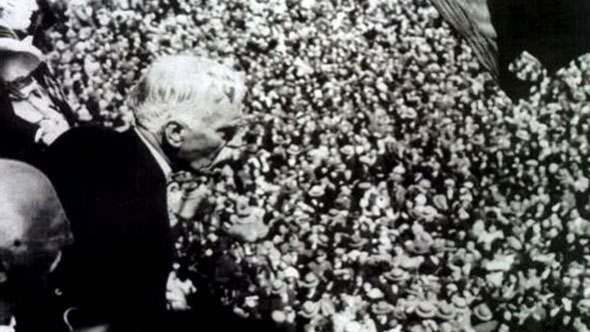Derecha de Cataluña: monarchists in favour of King Alfonso XIII and against the Second Spanish Republic and the Autonomy of Catalonia (1931-1936)

Derecha de Cataluña was the party that represented the Catalans monarchists in favour of the King Alfonse XIII during the Second Spanish Republic. Its activities are not well known because they have had a lack of social presence in Catalonia between 1931 and 1936, although the availability of financial resources that permitted them to fight for overthrow the regime and its role during this period and for this reasons, this party cannot be neglected. Public actions were well known, but the lack of political representation not allowed them to stop the development of events. Its voice in the Parliament was the voice of its Spanish partner Renovación Española, as well as the press addicted as Diario de Barcelona, conferences, meetings. etc. They were not able to establish permanent alliances with other extreme right-wing parties as Comunión Tradicionalista, Falange, JONS, etc.
In proclaiming the Spanish Republic, the monarchists around the State created in Madrid, the cultural centre call Acción Española, and a magazine of the same name, to spread their ideology. A few months later was created in Barcelona, Peña Blanca, as the same purpose.
Both entities were the core of the parties Renovación Española and Derecha de Cataluña.
After the failed attempt to redirect into space monarchist, the party Acción Nacional (later Acción Popular), Antonio Goicoechea and people who are faithful him, he was decided in early 1933 to found Renovación Española and almost simultaneously the Catalan subsidiary Derecha de Cataluña, defined both as a monarchist, Catholic anti-democrats, anti-parliamentarians, centralists and corporatists, with the basic aim of restoring the monarchy by legal or illegal means.
Without social support but with economic means, they chose the path of conspiracy because they have the favour a part of the gentry’ class, an important sector of the Army and the reactionary clergy. Despite to lose in all electoral contests, Derecha de Cataluña becomes in a factual power.
They had personalities such as: José de Olano y Loyzaga, count of Fígols; Darío Rumeu y Freixa, baron of Viver; José Maria Milá y Camps, count of Montseny, Alfonso Sala, count of Egara, Fernando Álvarez de la Campa, etc., posts, all of them, reached during the dictatorship, but they want to give an image of modernity and ceded the protagonist a young people as: Santiago Torent Buxó, José Bertrán Güell, Aurelio Joaniquet, Jorge Girona, Enrique García-Ramal, Santiago Nadal, etc.
At the end of 1934, the main leaders of Derecha de Cataluña signed the Manifesto which constituted the Bloque Nacional de Derechas of José Calvo Sotelo initially constituted by parties around Renovación Española and, of course, Derecha de Cataluña. 19 percent of the signatories of the Manifest were Catalans.
Strongly Spanish nationalists, Derecha de Cataluña was in favour of the coup d’état and they paid the expenses of UME (Unión Militar Española) in Catalonia and contributing to the military uprising on July 18, with money and people. On 19 April 1937 they were adhered to the Falange Española Tradicionalista y de las JONS of the Franco’s Dictator.
The Derecha de Cataluña’s representation in the Parliament was Renovación Española, and they were agreeing with all the initiatives of its partner: in favour of suspend the autonomy of Catalonia and laws derived: Generalitat, the Agrari law, the University autonomy and the cultural institutions as Institut d’Estudis Catalans.
Members of Derecha de Cataluña fought alongside the military rebels. At the end of the thesis you can find the list of people who left the life in the War, people who returned and the people who occupied posts in Franco’s regime as well as those who chose to make a “controlled opposition” accepted by the Dictator and its participation in the Private Council of the Count of Barcelona.
Basically, Acción Española and Renovación Española-Derecha de Cataluña, despite of the fascist aesthetic, filled the ideological contents the first decade of the Franco’s regime, because its ideology is not more different of the principles of Falange (Spanish fascist party).
The social class represented by Derecha de Cataluña, in which there must also include the more conservative and less liberal sector of the Lliga, were the leaders of the Franco’ regime in Catalonia, except the Unions, which were controlled by Falange.
References
“Derecha de Cataluña: monárquicos alfonsinos contra la Segunda República y la Cataluña autònoma (1931-1936)”, Josep Arqué Carré doctoral thesis, supervised by doctor Francesc Vilanova Vila-Abadal and read at the Department of Modern and Early Modern History.


